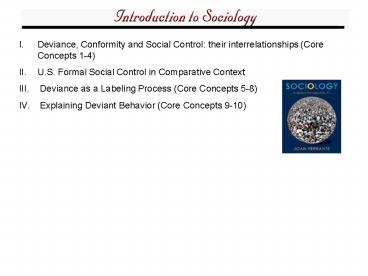Deviance, Conformity and Social Control: their interrelationships Core Concepts 14 - PowerPoint PPT Presentation
1 / 17
Title:
Deviance, Conformity and Social Control: their interrelationships Core Concepts 14
Description:
Video Clip on Sexual Harassment. Core Concepts 5-8: Deviance as a Contested ... focus on the question of who engages in deviant behavior and who does not ... – PowerPoint PPT presentation
Number of Views:530
Avg rating:3.0/5.0
Title: Deviance, Conformity and Social Control: their interrelationships Core Concepts 14
1
- Deviance, Conformity and Social Control their
interrelationships (Core Concepts 1-4) - U.S. Formal Social Control in Comparative Context
- Deviance as a Labeling Process (Core Concepts
5-8) - Explaining Deviant Behavior (Core Concepts 9-10)
2
Discussion Question What is distinctively
sociological about Ferrantes approach to
deviance in this chapter?
3
Society Society (social audience) as the source
of deviance Start with conformity socialization
and informal social control Formal social control
as a backup The normality and functions of
deviance Deviance as the outcome of a social
labeling process Definitions of deviance as
constructed through a social process Authority as
a source of obedience (following or breaking
norms) The structure of society as a source of
conformity and deviance (structural
strain) Differential association deviance as
conformity Individual deviant or conformist
4
Think about how this famous picture illustrates
the themes in the previous slide
5
Discuss Why does Ferrante focus on China in this
chapter?
6
- Core Concepts 1-4 Deviance and Society
- Norm violation and social audience
- Socialization and informal social control
- Mechanisms of formal social control
- The normality of deviance
7
Crime brings together honest men and
concentrates them. There is, then, no
phenomenon that more represents the symptoms of
normality, since it appears closely connected
with the conditions of all collective
life. --Emile Durkheim
- Why did Durkheim consider deviance and crime to
be both normal and functional for society?
8
- U.S. Formal Social Control in Comparative Context
- The United States has the highest incarceration
rate in the entire world - The United States had the fifth highest number
of executions in the world in 2007 (after China,
Iran, Saudi Arabia, and Pakistan)
What do these facts suggest about U.S. society?
9
Core Concepts 5-8 Labeling Theory and Stigma
Contests
Video Clip on Sexual Harassment
10
- Core Concepts 5-8 Deviance as a Contested
Labeling Process - The social audience and labeling
- Claims-making and stigma contests
- Recent and current examples
11
Labeling No Yes
No Yes
Norm violation
Deviant labels are often master statuses
12
Labeling
PrimaryDeviance
SecondaryDeviance
William Chambliss, The Saints and the Roughnecks
13
The Milgram Experiment
- What was the Milgram experiment?
- What did it demonstrate about obedience to
authority?
14
- Core Concepts 9 10 Explaining Deviant Behavior
- Structural Strain
- Robert Mertons key point the level and type of
deviance in society is determined by its social
structure - How does this occur? What structural
characteristics of society does Robert Merton
focus on?
15
- key sociological point origin of deviant
behavior lies in society, not the individual
16
- Core Concepts 9 10 Explaining Deviant
Behavior - Differential Association
- focus on the question of who engages in deviant
behavior and who does not - sees deviance as learned behavior
- in this perspective, deviance is treated as a
type of conformitywhat does this mean?
17
A Question To Reflect On Do the concepts and
ideas discussed in this chapter have relevance
for the way the current election has played out?































